|
Clubman Cup
Rating: **1/2
Participants:
12
Level: 5
----------------------------SPORTS CLASS----------------f---------
Tsukuba Circuit (6 laps)
(1,500) 18.52 - 81 hp
(2,000) 19.05 - 105 hp
(2,400)
20.00 - 120 hp
(3,200) 24.43 - 131 hp
Tokyo Route 246 (3 laps)
(1,500) 13.39 - 112 hp
(2,000) 15.15 - 132 hp
(2,400) 17.02 - 141 hp
(3,200) 19.63 - 162 hp
Cape Ring Periphery (3 laps)
(1,500) 23.51 - 64 hp
(2,000) 26.31 - 76 hp
(2,400)
27.27 - 88 hp
(3,200) 32.00 - 100 hp
----------------------------TUNER CLASS-------------------------
Tsukuba Circuit
(1,500) 14.42 - 104 hp
(2,000) 15.87 - 126 hp
(2,400) 16.78 - 143 hp
(3,000) 19.87 - 151 hp
(4,200) 23.73 - 177 hp
Tokyo Route 246
(1,500) 10.79 - 139 hp
(2,000) 13.75 - 145 hp
(2,400) 14.54 - 165 hp
(3,000) 16.22 - 185 hp
(4,200) 18.92 - 222 hp
Cape Ring Periphery
(1,500) 18.99 - 79 hp
(2,000) 21.50 - 93 hp
(2,400) 22.86 - 105 hp
(3,000) 25.64 - 117 hp
(4,200) 31.58 - 133 hp
--------------------Trucks, SUVs,
& MPVs---------------------
Tsukuba Circuit
(2,100)
17.21 - 122 hp
(3,500) 20.96 - 167 hp
(4,000) 23.12 - 173 hp
Tokyo Route 246
(2,100) 11.73 - 179 hp
(3,500) 17.33 - 202 hp
(4,000) 18.87 - 212 hp
Cape Ring Periphery
(2,100) 23.59 - 89 hp
(3,500) 27.34 - 128 hp
(4,000) 30.77 - 130 hp
*Cars known to handle well can enter the Sports Class, which requires less power. Those with tricky handling
(longer brake distances, more understeer, more sliding, harmful oversteer, etc.) can use the Tuner Class.
** Trucks, MPVs, and SUVs is a class for taller vehicles, which haven't got the sleeker aerodynamics of typical coupes,
sedans, and hatchbacks.
*If the Ford Focus RS, '07 Mazda Roadster RS Honda S2000, or '97 Toyota
MR-2 show up and start in at least 5th place, add
5 hp per position.
In other words, if any of these three start in 5th place, add 5 hp. 4th place? Add 10 hp.
Pole position? Add 25. So far, I'm not noticing any major jackrabbits except
these four.
There are also a few lesser rabbits to watch for: Audi A3 3.2 quattro, BMW 120i, Mazda Savanna RX-7,
Nissan 180SX Type X, '78 Nissan Fairlady, Nissan Sil80, and Nissan Skyline GTS-t Type M.
These can be started no higher than 4th or 5th to keep them from possibly jumping ahead, or started on or near
pole for more challenge.
Description:
Here we have a 3 race series, 3 to 5 laps each, which
can be done individually, or consecutively as a championship for points. The caption for this race is "Welcome to the
Clubman, a race for beginners", which is a warning to us GT veterans. Because these races are too
frickin' easy. The Clubman belongs in the Beginner's league, I have no idea why it's the start of the Amateurs.
The
Clubman and the Sunday Cup used to be side by side in Gran Tusismo 1, 2, and 3, but starting in GT4 were separated by an entire
area. One thing hasn't changed, though. The Clubman has always represented the first major step towards GT stardom. Win
the Sunday Cup? Well, anyone can do that! The Clubman usually requires more of everything: more power, more wits, better
driving, and perhaps a better car than what was used during the Sunday Cup/Beginner's Series. For GT5 we can insert the word
"slightly". We'll need something slightly faster, slightly better.
Starting with GT5, Polyphony
Digital has now started a new policy: we can no longer do practice laps once we're entered into the race series.
Ridiculous. To get around this it is recommended to save the game after tuning. Save, exit the race series by pushing the
controller's central PS button, and then restart the game. Now that we're back in the game we can do some practice laps by
letting the entire field get far ahead. Exit the game, and finally restart it.
This is especially necessary because
there's a new track on the roster: Cape Ring Periphery. Take the time to learn it in detail, especially the
the deadly Z-turn area into the triple left bends.
It doesn't take much power to win these because I made an executive
decision and have tried to calculate the above ratios for just one tire type (Medium Sports). Lesser tires can be used
if you find yourself skooling the Ai and need more of a challenge.
Try not to enter any cars that have their powerband flattened
a lot with a limiter (like any machine with more than 140 hp while stock, seriously). Cape Ring is the exception here. Most
cars WILL need a lot of limiting.
Opponents:
We have quite a variety of
cars, lots of familiar faces, but also a handful of new ones.
Class A: Look
for the Ford Focus RS, '07 Mazda Roadster RS, Honda S2000, or '97 Toyota MR2 GT-S most
of all. Oddly, none of these appear on the roster of possible cars which can show up, yet they happen to be the strongest.
They can make it towards the front of any race, even if they start behind us.
Class B: The
Audi A3 3.2 quattro, BMW 120i, Mazda Savanna RX-7, Nissan 180SX Type X, '78 Nissan Fairlady, Nissan
Sil80, and Nissan Skyline GTS-t Type M are also mild jackrabbits if they start
near Pole, but don't always do so well if they start downfield. Sometimes yes, sometimes no.
At times it feels as
if this set of races is straight from GT4, especially Tsukuba and Cape Ring. At Cape Ring it seems most of our opponents are
either stoned or sightseeing, as they drive portions of this track (especially the "ring" part) as though they're just "taking
it all in". Viewing that nice scenery going by! Notice how little horsepower is needed to survive here at Cape Ring.
The
Ai doesn't try very hard or take many chances, but keep in mind it sometimes does surprise.
Parts Used:
Medium
Sport tires
Hard Sport tires can also be used if more challenge is desired, even for Historic
Class entries.
Fixed Sport Suspension (those with tight handling
with stock parts shouldn't need this).
Height-adjustable Sport Suspension. This can be used to
try to get a tricky-handling car to "good-handling" status.
Limited-slip device, especially for those
with poor traction or tricky handling.
Close-ratio transmission for some at Tsukuba and Cape Ring,
only if the car truely needs it.
Full-custom transmission for those that need taller gears at
Route 246.
Single plate clutch + lighter flywheel
Cars used for
ratios
'91 Suzuki Cappucino (1,500 / fly-weight, good-handling)
'95 Mazda Miata S-special
(2,000 / light-weight, good-handling)
'83 Nissan EXA Canopy (2,400 / mid-weight, good-handling)
'04 BMW 120d
and 120i (3,200 / heavyweight, good-handling)
'66 Honda S800 (1,500 / flyweight, tricky-handling)
74 Triumph Spitfire (1,800 / lightweight, tricky handling)
'79 Datsun 910 SSS (2,400 / mid-weight , tricky
handling)
'62 Prince Skyline (3,000 / heavy weight, tricky handling)
'88 Volvo 240 GLT Estate (4,200 / ultra-heavy, tricky handling)
'03 Scion xB (2,100 MPV/Trucks)
'03 Honda Element (3,500 MPV/Trucks)
'03 Honda Odyssey (4,000 MPV/Trucks)
-------------------------------------------------------------------------------------------------

European Hot Hatch Championship
rating: **
Participants: 10
Level: 5
Eiger Nordwand (short track)
(1,000)
9.61- 104 hp
(2,000) 15.58 - 129 hp
(3,200) 20.78 - 154 hp
(4,200) 21.00 - 200 hp
Rome Circuit
(1,000)
10.10 - 99 hp
(2,000) 16.00 - 125 hp
(3,200) 19.63 - 163 hp
(4,200) 19.90 - 211 hp
Start these alpha cars no higher than 2nd at Eiger, 3rd at Rome. Alfa
Romeo GTA, BMW 120i, Citroen C4, MINI Cooper or Cooper S, Peugeot 206, Peugeot 207.
Sometimes,
one of the others, like a VW Beetle or Peugeot 106 or VW Lupo might spring ahead if they start on pole, but these cars don't
get as far.
Description
Wow, only two tracks to this series? Okay...
Both races are 3 laps apiece. Good
news is, the competition is tight. PD has mostly selected modern hot hatch types, and seems to have attempted to balance power
between them. For instance, I've seen a front-drive VW New Beetle eke out some distance over a rear-drive
BMW 120i, which has to be a first. The next race, a VW Lupo also held its lead over cars traditionally more aggressive
with track prowess. The only time a Beetle or a Lupo won anything in previous Gran Turismos would have been during
actual Beetle and Lupo cup races.
Another interesting tidbit is we aren't forced to just race hot hatches, it just
has to be Eurpoean. I've entered a '66 Beetle (classified in real-life as a 2-door sedan) a '68 Karmann-Ghia (coupe),
and an '88 Volvo 240 GLT. This is a plus for those who are trying to break the mold.
Opponents
Bad
news? Yes there is some. Both these races are usually predictable, even at Rome with its longer straight areas. The racing
can be tight, but whoever's up front is usually the same driver who's going to stay up front (unless we take over
his/her position). Usually. This is not set in stone 100% of the time, but let's say maybe 80% of the time it is, especially
at Eiger.
Though there aren't really any true GT4-style jackrabbits that get half-a-track ahead of everyone
else, it helps to keep any hot-hatch type (Alfa 147, Volkswagen Lupo GTI, Citroen C4, etc.) off of pole, just for the
sake of making the above weight-to-power ratios work best. The models listed below are slightly above the rest.
'02
Alfa Romeo GTA
BMW 120i Citroen C4 MINI Cooper
or Cooper S
Peugeot 206 RC (maybe the regular 206 as well) Peugeot 207 GTi
Then
again, if you really wanna go hardcore, find a grid with one of these (or more than) on the front lines! This is only
recommended for those who've a machine that's got some decent handling though. As mentioned, there are a few others like
the VW Beetle and VW Lupo (hot hatch types, basically) who will also do well at both races, but this assumes they start on
Pole.
Parts Needed
Soft Comfort tires for the majority of cars (front, rear or all-wheel
drive).
Hard Sport tires for some older cars like the Karmann Ghia. I also raced my '88
Volvo with these. Hard sports can also be used if any of the fastest cars mentioned above (in the Opponents section)
start on Pole. The Ginetta was raced with comforts.
Fixed Sport Suspension for those rare cars that need it. Most "hot hatch"
types typically have acceptable handling though, so go stock with these.
Close-ratio transmission
Assorted
drivetrain parts. The '80 Renault 5 Turbo, Ginetta G4, and Karmann Ghia will need LSD tuning, for instance. The '88 Volvo
will not, but it will need carbon driveshaft and a better clutch & flywheel.
Full-custom transmission,
assuming you're daring enough to use a '49 Beetle (ha ha).
Cars used for ratios:'
''64 Ginetta G4 S
II (flyweight / 1,000)
'68 VW Karmann-Ghia (lightweight / 1,700)
'04 BMW 120i & 120d (heavyweight / 3,200)
'88 Volvo 240 GLT Estate
(ultra-heavy / 4,200)
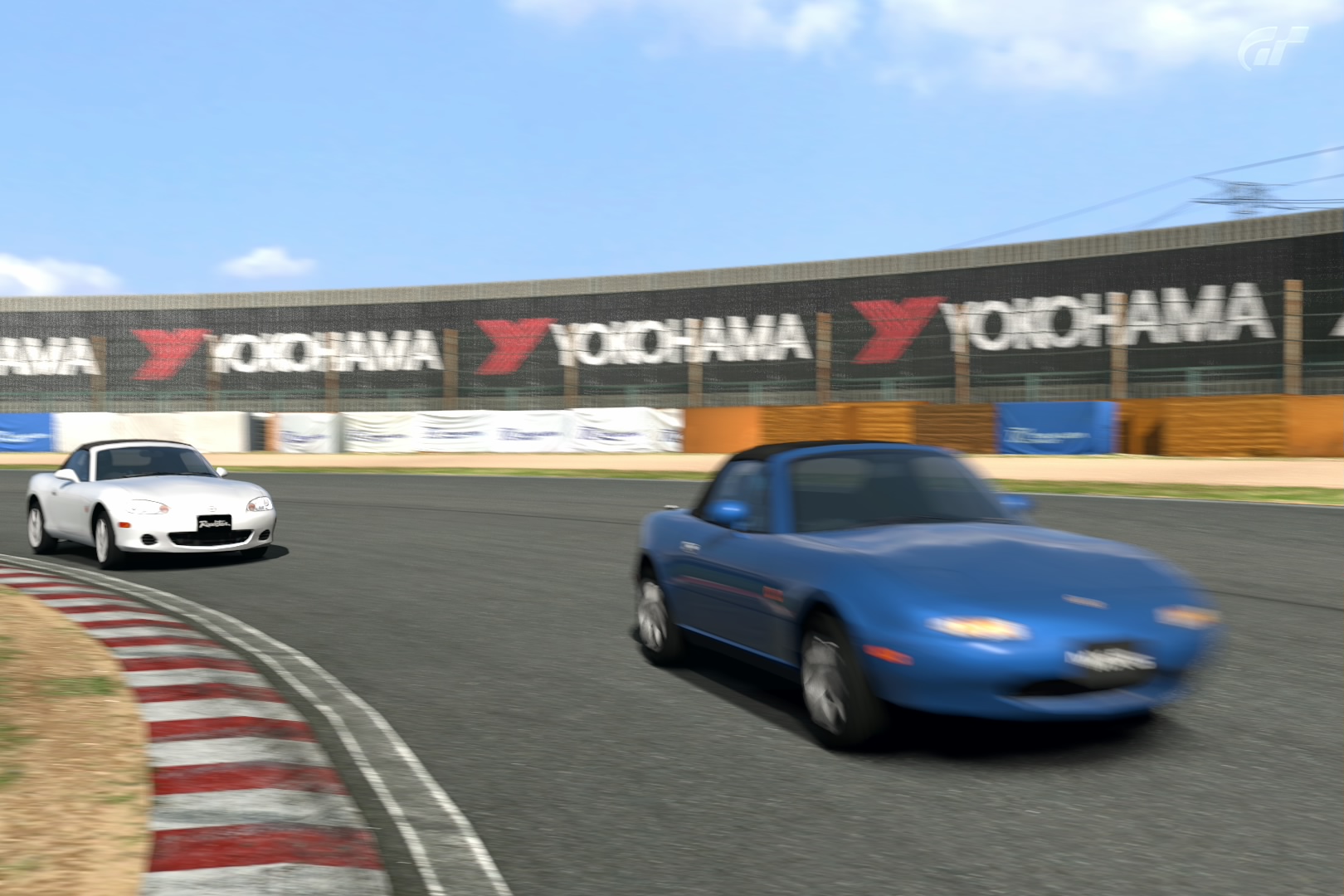
----------------------------------------------------------------------------------------------
NR-A
Roadster Cup
rating: ***
participants: 12
Level: 6
(2,000) 16.53 - 121 hp
(2,200) 17.19 - 128 hp
(2,400) 18.32 - 131 hp
Description:
Welcome back to Tsukuba, once again. Here we
have another one-make race held at just one track.
Any Mazda MX-5 can be used, but the best for us to use
will probably be coming from the Used Car Lot. The weaker, the better. These cars usually start with 115 to
125 horsepower. Somewhere down there. A small power boost (oil change, usually) might be needed to bring these older cars
up to spec.
There are a couple older Premium MX-5s as well, but it's possible for a spendthrift to find a cheaper
model from the used lot, if he or she is that concerned about money. The Premiums have have similar power to used cars,
though.
The newer '07 Mazda Roadster from the Premium lot can be used as well, but this one has a lot more
power than the older ones, which can make for a race that's not as exciting. bla blabla..
It's best to keep
our Miata or Roadster or MX-5 or Eunos Roadster as stock as possible, with the exception of maybe an oil change
or a phatter muffler. This makes things easy on our bank account, and also provides the best challenge.
Opponents:
PD
has played with power a bit, so that earlier model cars (which have weaker engines) are on the same page as later ones.
The result: no MX-5 really shines over another. There are rare times when one car will get ahead of others, but it seems like
this happens to be due to whoever's behind the wheel, not the car itself.
There are few passing zones.
Not for us, but for the enemy, who doesn't drive as aggressively into those turns as we can. So use those hairpins and curves
to advantage.
...And if you're having trouble, remember this race happens to be 5 laps. Plenty of
time to get situated and eventually defeat the enemy.
Parts recommended:
Soft
comfort tires
Cars used for ratios:
'All sorts of Miatas.
----------------------------------------------------------------------
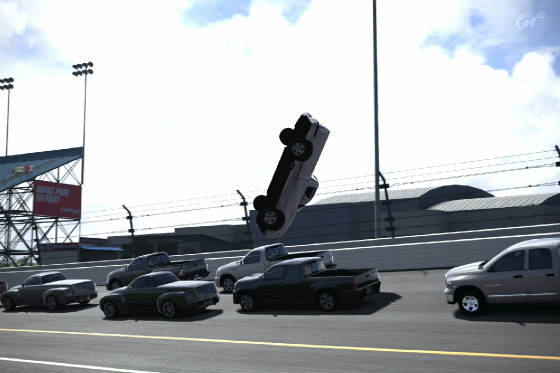
Pickup Truck Challenge
Rating: *
participants: 12
Level: 6
Laguna
Seca
(3,500) 12.87 - 272 hp
(5,000) 14.08 - 355 hp
(5,300) 14.68 - 361 hp
Daytona Superspeedway
(3,500) 10.17 - 344 hp
(5,000) 12.07 - 414 hp
(5,300) 12.61 - 420 hp :-)
Start the Toyota Tacoma no higher than 4th at Laguna Seca for a rather safe win. They
can be started 2nd or 3rd for those who want more challenge. Anybody can be started anywhere at Daytona
Description
Sorry to
start on a negative tone, but these events sucked in GT4 and they still kinda suck now. It's not so much that we have to race
trucks, it's the fact that we have to race them at a couple of tracks which don't highlight how fun truck-racing can be. I
think Toscana off-road would be a much better choice, for instance. Instead we get Laguna Seca. There's also the
fact that we have such a limited selection of vehicles to choose from. I still wanna race my Land Rover Storm in these
and still it cannot be done.
There's also the usual lack of power needed to complete these. I'm sure
all the noob drivers out there might have probs during the Pickup-truck races, but us pros will just blow 'em away. Well,
at Laguna we will. My initial drive in a Ford F-150 at Laguna Seca yielded an easy 2nd place, even though my truck was
completely stock (on radial tires) and needed an oil change. Daytona often poses more of a challenge, which will be outlined
below.
Finally, there's the prize: a Daihatsu Midget for all our troubles.
A Daihatsu. Midget.
Opponents:
In
GT4, the Chevy Silverado was the ultimate truck to watch for, everybody else was just about average. In GT5, this is no longer
so.
At Laguna Seca, I've only seen the Toyota Tacomas have the ability to make
headway over other trucks, possibly since Tacomas are the only ones with shorter 6-speed trannies (everybody else
has gearboxes that are too tall for usefulness). Other than the Tacomas, nobody really jumps far ahead of anybody
else. Even the Silverado lags behind, sometimes even if it starts on pole. Start the Tacomas no higher than 4th place, and
you'll rarely have to worry about anybody else.
Daytona is a different story. Everybody is on the
same page here, since they're all drafting, bump-drafting, and punting each other. It can be challenging to wind up being
the one who's in first exactly as the race ends; this requires strategy and timing.
For those who have not downloaded
Update 2.0, be aware that that the Ai at Daytona can be very aggressive. They have a tendency to pit-maneuver
and spin us if they don't like what we're doing. It can get annoying because they will not spin each other, only us.
After 2.0, however, things only improve. Not only are they more civil on those tracks, the enemy has a tendency to actually
work with us at times, nudging our truck (and other trucks occasionally) with bump-drafts.
Tip
1: One thing we can do at Daytona pre-2.0 (if you don't mind a bit of immersion-breaking) is to race in 3rd person mode,
so that the camera is behind the truck. This helps a bit to see who's around you, behind you, and about to punt you. Switching
to bumper cam (mirror only) helps at certain moments, too.
Tip 2: I've had mild success bump-drafting another truck,
and pushing that single truck far ahead of the pack early during Lap 1. Usually, a lighter Tacoma or Chevy SSR make the
best bump-draft partners, heavy trucks like the Ram mostly soak up our bumps. It's possible to push this truck ahead of everyone
else, get ahead of it, let it catch your draft and pass you, and finally draft or bump-draft it again.
This
works sometimes. Other times, the opponent truck seems to freak out, and wiggles out of our way just when we're
trying to land its bumper. Dumbass! I'm trying to HELP you!
Parts Needed:
Soft
Comfort tires at Laguna Seca
Hard Sports at Daytona
Sport Suspension (either one) Daytona, especially for the taller Americans
Close-ratio transmission for some models at Laguna Seca
Full-custom transmission for the Toyota Tacoma at Daytona. Some others may also need
this to get a more efficient gearing scenario.
Drivetrain parts as needed.
Trucks used for ratios
Toyota
Tacoma X-Runner (3,500)
Chevrolet SSR (3,800)
Ford F-150 SVT Lightning (4,700)
Dodge Ram 1500 Quad Cab (5,300)
-----------------------------------------------------------------------------------
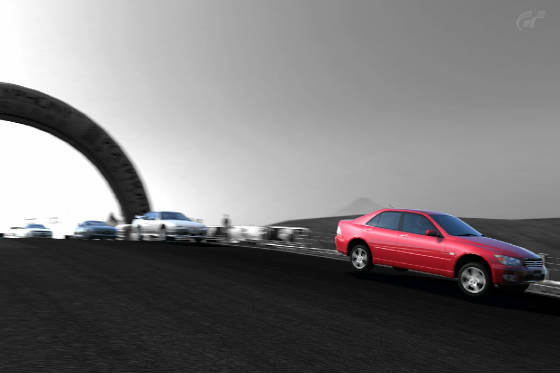
Japanese 90's Challenge
Rating: *
Participants: 8
Level: 7
Tsukuba
(1,200)
11.88 - 101 hp
(2,000) 16.94 - 118 hp
(2,500) 17.24 - 145 hp
(3,000) 18.63 - 161 hp
(4,000) 19.23 - 208 hp
Cape Ring North
(1,200)
13.79 - 87 hp
(2,000) 20.43 - 98 hp
(2,500) 21.93 - 114 hp
(3,000) 23.80 - 126 hp
(4,000) 24.24 - 165 hp
*The above ratios assume
the best rear-drives (MR2s, Miatas, MX-5s, Silvias, RX-7s) are kept off Pole position at Tsukuba. Any
rear-drives not mentioned, like the Supra SR-Z or Altezza, will not matter. More power may be needed, especially at Tsukuba,
if they start on Pole, assuming a rear or all wheel-drive has not been entered. On the other hand, if a RWD or AWD has been entered, a lot of times it's a good idea to put some better competition
up front.
A lot of grids happen to have one of the better rear-drives on pole, so if the entered car is a lesser FF
or a Kei (etc.) it might be a good idea to add a few horses. No more then 10.
Or be patient and look for a lesser Pole driver. At Cape Ring, ignore
all these guidelines. Anybody can be started anywhere, in most cases it's best to go ahead and keep competition as high as
possible.
Description:
Now it's time to race amongst
a who's who of Japanese sports cars from the '90s! The 1990s were arguably the best, most competitive of times from the
Japanese Domestic Market. Both of these are 5 laps. In some past GT games the Japan-only races have been pretty decent, so
let's get psyched!
Unfortunately, the reality. So many people have complained about the lack of racing in A-spec
mode (in comparison to GT4) and unfortunately I think I'm starting to get it. In GT4, there were FIVE Japanese 90's
events. Now we're down to just two.
When buying a car, make sure you're getting one of JDM's slowest
representations. Chances are, you will not need an NSX, a turbocharged 240SX, an Integra or even a Starlet Glanza;
such cars will simply blow the way through the melee with seconds to spare. Instead, look for a Yaris, a front-drive Celica,
or a Miata. Sadly, it doesn't take much to win these two races. I'm about to start looking at some Keis in an effort at truer
competition!
Tsukuba can be accomplished with minimal (if any) power-ups. I've made sure the
racing is good here, but in most cases some power-restricting will be involved, even for cars which already seem weak.
Cape
Ring North, on the other hand, is so friggin' EASY. Even with stock power (137 hp) my Silvia
Q's was smoking the Ai, especially when we all got to the "ring". It's a guarantee most cars you'll race here will need to
have their limiters hacking some serious power, unless you've sunk to Yaris or Kei car levels. Sad.
Opponents:
They
all rate just above or below 200 hp, and drive with the sort of safeness that makes for a rather boring set of races. Update
1.10 (which has just been released at this writing) is supposed to make GT5's drivers more witty and challenging, which makes
me glad I never did the '90s races before 1.10.
If you're wanting to see some sparring between the Ai, one thing that
can be tried to liven things up is to start lesser front-drives (a Celica SS-II for instance) in front of rear-drives
which are known to be dominant during other events (Miatas, MR2s, Altezzas, etc). This works sometimes, other times it doesn't.
Parts
needed:
Medium Comfort tires against easier grids (Tsukuba) and all grids at Cape Ring.
Soft Comforts can be used against grid packed with rear-drive sports cars near pole,
at Tsukuba, if needed.
Hard Sport tires for the Daihatsu Midget at Tsukuba. I haven't encountered any others so
far that need this particular upgrade. Soft radials can be used at Cape Ring for this model, though. Fixed
Sport Suspension for a few which really need these parts. Some Keis, for instance. Most full-size cars should
be on their default suspensions.
Close-ratio transmission, perhaps. If the car somehow really needs some help. A full-customized
tranny can be used if it really needs help.
Drivetrain parts as needed
Cars used for Ratios:
'98 Daihatsu
Midget (1,200)
'99 Toyota Yaris (1,800)
'91 Nissan Silvia Q's (2,500)
'97 Toyota Celica SS-II (3,000 ... lots of ballast here)
'96 Mitsubishi GTO
SR (4,000 ... more and more ballast)
---------------------------------------------------------------
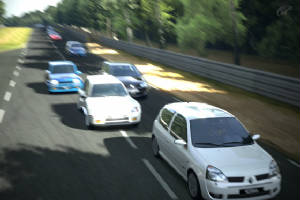
Tous France Championnat
rating: ***
Participants: 12
Level: 7
Circuit de la Sarthe
(2,000) 12.34 - 162 hp
(2,500) 14.20 - 176 hp
(3,500)
18.23 - 192 hp
(3,800) 18.72 - 203 hp
Madrid Circuit
(2,000) 14.59 - 137 hp
(2,500) 15.62 - 160 hp
(3,500) 20.23 - 173 hp
(3,800) 20.21 - 188
hp
*At Sarthe the fastest cars can be started in any position. Start
them downfield for a fair fight, or put them on or near pole for more challenge.
* At Madrid, more power might
be needed if any of the faster MR RR, or 4WDs mentioned in the Opponents section sits on 1st or 2nd place. Add up to 10 hp if this is the case.
*IF any of the faster FWD opponents
listed in the opponents section sit on or near pole at Madrid, do not change power unless your car is a competent handler.
Remove 20 to 30 hp if this is the case. This power can also be deducted
if you simply need some more challenge, even if your car isn't so good with handling, because the front-drives do Madrid way
too conservatively.
* If NO faster cars (FWD or any other drivetrain) sit on or near pole at Madrid, try docking
up to 50 hp! In some cases, even more than 50 might be appropriate.
....And keep in mind that sometimes the Ai drives so timidly at Madrid that it doesn't seem to matter how much power
we remove here. You can try going further than 50, but then you risk the chance of a better set of drivers suddenly showing
up.
Description:
Viva
le France! Comment 'alez vous? Never mind, I fell asleep in French class back when I was forced to take it in middle school
so...
....Now it's time to race some French cars! Though there isn't as large a selection of Frenchmobiles as there
is Japanese, American, and English, we still have a variety to choose from. Everything from the monster Renault Clio
Sport V6s to the lowly Citroen 2CV can be entered. Drivers like you and me, of course, will probably want to choose neither
one of these. One is a slug, the other a walkover-machine.
Tous France isn't really all that challenging (unless
you drive an old classic with no ABS!), and again, not much power is needed to succeed. But the racing itself is decent at
times. Decent and close.
Opponents:
Watch for the mid-engined Hommell Berlinette
and Renault 5 Turbo most of all, but there are some front-drives (any 1-series thru 3-series Peugeots
and Renault Meganes), 4-wheel drives ('85 Peugeot 205 Turbo), and rear-engine cars (Alpines) that
can compete up front, too.
I have yet to see a Clio Sport V6 show up in these. If it does, it should also be
added to the above list.
Traffic can be mildly agro at Sarthe, lightly punting and skewing us sideways just
as we're trying to make a perfect entry into the turn at the end of the Mulsanne. Truthfully, it's not entirely their fault.
The Ai here tends to run a tight race, all 12 cars rubbing and getting into each other's business. They also draft one
another effectively down those straights. There's only so much room for them to maneuver by the time the turns approach, meaning
we'll find ourselves caught up in the melee at times.
At Madrid, the main difference is passing zones are much more
restrictive, meaning the better enemy cars listed above won't always make it to the front, even if they start in 3rd thru 5th
place. Only if one of them is sitting on pole or 2nd might we need to add a small amount of power, but this assumes the
car we've entered has some mediocre handling, or some other such problem. Cars which are more confident might need to have
some of the better opponents starting way up front.
Parts:
Soft Comfort tires
Fixed or Height-Adjustable Suspension for Historic (non-ABS) cars.
Modern cars can often use factory suspensions.
Full-custom transmission at Sarthe for some cars. Gearboxes should
be tuned somewhere around 155 mph.
Close-ratio transmission at Madrid for
some
Drivetrain parts as needed
I raced a Renault 5 Turbo with no ABS, but included a limited-slip device.
This part will also be needed when driving Alpines (also with no ABS).
Cars used for ratios:
'80 Renault 5 Turbo & Peugeot 106 Rallye (2,000)
'02 Renault Clio 2.0 16v (2,300)
'98 Peugeot 406 3.0 V6 (3,500)
'02 Renault Avantime (3,800)
---------------------------------------------------------------
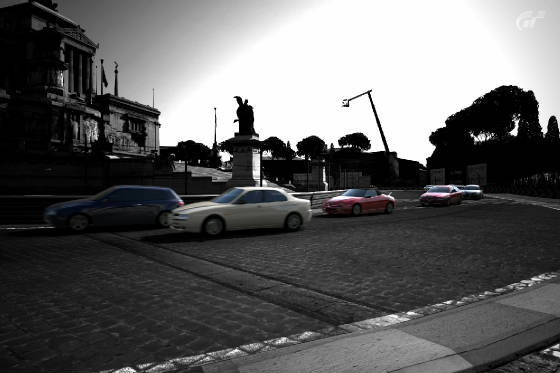
Festival Italia
rating: ***
participants: 10
Level: 8
Rome Circuit
(1,500)
11.28 - 133 hp
(2,000) 14.08 - 142 hp
(3,500) 19.44 - 180 hp
London
(1,500)
12.00 - 125 hp
(2,000) 14.81 - 138 hp
(3,500) 21.34 - 164 hp
*If the Autobianchi, and any Alfa Romeo GT
or GTA models (historic or modern) start on or near pole position, 10
hp may need to be added, especially at Rome.
* the Lancia Stratos will demand even more power
if it shows up, sometimes even if it starts at last place. Again, this is truest at Rome. Remove 10 horses if none of these better machines make a showing:
'79 Autobianchi (starting in front of us), any Alfa GTAs, Alfa Romeo GT 3.2, '65
Alfa Romeo GTA Sprint, and most importantly, the '73 Lancia Stratos.
Description:
The "Italia Festival" follows GT5's odd trend of two races held at two tracks, 3 laps
per. Dismal, but at this point, I'm personally getting used to this game's lack of additional racing. One can only hope
the Pro league gets better, or some new events get introduced via updates or DLC or whatever.
And it sucks because
most of the racing is actually decent, unlike some of the other Amateur Series. Again, this assumes you've
got a car which hasn't got much power (Lambos and Ferraris? No.) and it also assumes our cars are stock with suspension, brake,
transmission/drivetrain, and sometimes tires.
Opponents:
There is some good
racing here, as noted above. Perhaps it's due to the fact that both tracks have few passing zones, and the passing zones
which do exist are to be found at some of the narrower parts of London and Rome. There's also GT5's familiar roster of
drivers, some aggressive, and some more cautious. All of this adds to the fun at these two tricky tracks.
Surprisingly,
older models do really well here, to the point of jackrabbit-dom at times. This includes (get this) that
car so many of us have made fun of, the car we've all sold multiple times after winning it as a prize in both GT4 and
GT5, the '79 Autobianchi A112 Abarth! I've seen this front-drive city car pwn
some of Italy's more modern autos. At Rome, be prepared to watch as the Autobianchi can jump from last place all the way to
the front lines!
The only really true jackrabbit, though, is the '73 Lancia Stratos,
which isn't really a surprise. If it makes its way to the front, there's simply no stopping it, and you'll need to start over
with more power (I'm guessing at least 20 hp more) if you want to catch up to it. It might be prudent to keep the Stratos
out of the race altogether, actually. It's kinda like the Shelby Series 1 when it shows up in the Beginner League's FR Challenge.
And there is some other bits of sparring here and there with the sim cars, all of which is welcome
and makes me wish there was more racing, more laps, and at least one more track (Monza) to race at. Sigh.
Parts:
Soft
Comfort tires
Hard Sports perhaps for Italy's poorer-handling cars.
Close-ratio transmission
at either track, for those with tall gears.
Single-plate clutch and better flywheel for those who need a little help.
All
else generally stock.
Cars Used:
'65 Alfa Romeo Giulia Sprint GTA (1,500)
'66 Alfa Romeo Spider
'98 Alfa Romeo 166 2.5 V6 24v Sportronic
-------------------------------------------------------------------
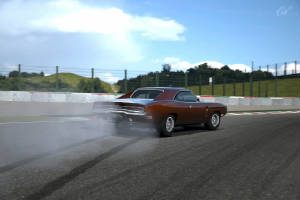
Classic Muscle Car Championship
rating:
***
participants: 12
Level: 8
Autodroma Nationale Monza (3 laps)
(2,400) 8.39
- 286 hp
(3,000) 10.30 - 297 hp
(3,500) 11.04 - 317 hp (4,000)
11.69 - 342 hp
The above ratios represent races in which the fastest cars (see Opponents
section below) do NOT start on or near pole position (1st or 2nd place). Add 5 to
10 horsepower per position over 3rd, depending if the car being driven is a lightweight pony or a heavier
model.
** The above ratios were created with the worst models. If a smaller, nimbly-handling car is driven
(Camaro, Mustang, Corvette, etc.), use 10 hp less, or Hard Sport tires.
***The only exception to this rule: the '53 Corvette used to make the 2,400 pound ratio used the power
stated above. But if this car had been driven with its factory weight of 2,885 pounds, it would have had its power slightly
deducted. Confused?
Description:
Once again, we have just one track to race
at.
> It's easy to buy a full-modifyable transmission, gear it higher than usual, and slaughter if you've got some
power added. But if you're restricting that muscle, this race actually feels competitive with full-custom gearing. Chances
are, some restriction will be needed in most cases.
> Those who opt to drive with a stock
gearbox instead, there's usually only one or two areas of the track where the RPM limiter will get us, depends which
car.
Opponents:
Our opponents are all on medium sport tires, and I was fearing I'd have to break out
the Comforts to make this race artificially challenging, but this seems not to be the case...
Notice there's a 3-star
rating at the Monza CMCC. The actual racing is pretty good! There are lots of position changes, lots of jockey-moves by our
opponents during the entire race...from straights to corners. Normally, I'd complain about the TCS the Ai is using, but
at this level, it simply helps them drive their best, and makes these races not quite the walkover I was expecting.
There
are a few alphas, though. Typically, it'll be the Corvettes, and some of the "pony cars" that show up.
These handle a bit better than the others, and were used in real-life circuit racing back in the '60s and '70s. Here's
a list of all.
any Chevy Camaros
any Chevy Corvettes (especially
the '69 Stingrays)
'65 Shelby Mustang
'67 Mercury Cougar
The Dodge
Challenger should be on the above list, but its gearing is way too short. Actually, here are my observed top speeds for most
of these models, from fastest to slowest. Those with an asterisk next to their speed meet their RPM limiter down the
last straight or two (which is most).
'63 Chevrolet
Corvette Stingray
148 mph '69 Chevrolet Corvette Stingray Convertible 137
mph* '70 Chevrolet Chevelle SS 454
134 mph* '65 Shelby Mustang GT350R
130 mph* '69 Dodge Charger Super Bee 426
130 mph* '69 Chevrolet Camaro Z28
128 mph* '70 Plymouth Superbird
128 mph* '69 Chevrolet Corvette Stingray Coupe
122 mph* '67 Mercury Cougar XR-7
119 mph* '70 Plymouth 'Cuda 440 Six Pack
117 mph '69 Chevrolet Camaro SS 114
mph* '64 Pontiac Tempest GTO
113 mph* '70 Dodge Challenger R/T 112
mph*
Jackrabbit situations (where one car gets far ahead of the others) do occur, but they're rare. Usually it'll be
due to one car getting thru congested traffic jams successfully, not one car with some huge advantage over the others. Even
the lightest car of the field (the Shelby Mustang, which is several hundred pounds less than everyone else) has probs being
tops, since its gearbox is too short.
Parts Needed;
Medium Sport tires
Hard
sports can be used if more of a challenge is desired, especially if you're driving a Corvette or one of the ponies
mentioned above.
A combination of Hard front and Mediums rear might work with some cars (especially if ABS is not being
used). This will diminish rear-end burnout madness, but will also create more noticeable understeer.
Full-custom
gearing for some. Set gears for about 160 mph (261 km/h). This is higher than a lot of muscle can attain at this
track, but the idea is to try and capture peak power, which is usually mid-range in a lot of muscle.
Everything else
stock.
Oh, no ABS or brake balancer, please
Cars used for ratios:
'53 Chevrolet
Corvette (2,400)
'69 Chevrolet Camaro Z28, '64 Pontiac GTO (3,200)
'70 Dodge Charger (3,700) '70 Charger Super Bee 426 Hemi (4,000)
----------------------------------------------------------------------
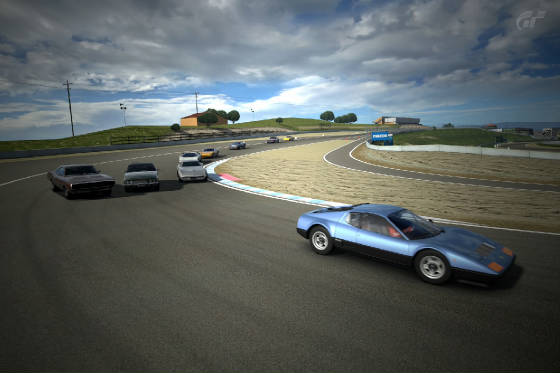
Supercar Nostalgia Cup
Rating:
***
participants: 12
Level: 9
Sports Cars
Rome Circuit
(1,000) 3.66 - 273 hp
(2,000) 6.19 - 323 hp
(3,500) 8.73 - 401 hp
Suzuka Circuit
(1,000) 3.78 - 264 hp
(2,000) 6.35 - 315 hp
(3,500) 8.41 - 416 hp
Laguna Seca
(1,000) 4.11 - 243 hp
(2,000) 6.94 - 288 hp
(3,500) 8.90 - 393 hp
Touring Cars
Rome Circuit
(1,800) 5.32 - 338 hp (2,100) 5.91 - 355 hp
(2,500)
6.41 - 390 hp
(3,000) 7.16 - 419 hp (3,500) 7.71 - 453 hp
(4,000) 8.78
- 477 hp
Suzuka Circuit
(1,800) 5.26 -
342 hp (2,100) 6.02 - 349 hp
(2,500) 6.74 - 371 hp
(3,000)
7.54 - 398 hp
(3,500) 7.90 - 443 hp (4,000) 8.47 - 472
hp
Laguna Seca
(1,800) (2,100) 6.19 - 339 hp
(2,500) 6.96 -
359 hp
(3,000) 8.20 - 366 hp
(3,500) 9.00 - 389 hp (4,000) 9.97
- 401 hp
*Touring Car class includes typical 4-seaters or 2+2s. The Sports Car class is being designed more specifically for
2-seaters, though it's possible there may be that oddball which can be moved from one class to the next.
**In general, keep the Lamborghinis as downfield as possible, 3rd place at the highest for a Countach,
4th place for a Miura. Ferraris, Corvettes and Jensens (in that order) are usually 2nd, 3rd, and 4th compared to
the Lambos.
*** Not all 'sports cars' are created equal. I recently raced a Ferrari 512 BB that wound up needing the Touring
Car class to survive. Corvettes and other bad handlers might also need this class, though I did use a highly-modified '69
Stingray to create the Sports Class 3,500 pound heavyweight ratios.
Description:
Here's a set of events that're looking like could be interesting, and there's actually
more than two tracks to show up to! All are 3 laps. Choose a car from 1979 or earlier, one which has
some actual power (YES!) and you're generally good to go.
The drivers we're up against are
all in so-called "supercars", but we don't have to be. Therefore, I plan on racing that Camaro I just drove at Monza, and
look forward to taking some other cars in the future which are not from the "super" or "muscle" categories.
One
thing that's guaranteed: in many cases, we'll be adding some power, not restricting it. That's good news, eh? Woulda
been nice to see some of this action during the Japanese '90s races.
Opponents:
PD seems to
have chosen some top cars from back in the day, but we only have 5 makes to race against. What's odd is the way the grid
is arranged. Notice it goes in a pattern: The Jensen Interceptor is followed by a Countach, a Ferrari, another Lambo, a '69
Stingray, and from here the entire line-up repeats itself starting with the Jensen, the Countach, etc. There are variations
of this pattern from race to race, but the pattern itself always repeats. A small oddity not seen before from PD,
or maybe I've just never noticed this.
The races are mostly predictable...the Italians (Ferraris and Lambos) getting
a sizeable jump on everybody else, and there is a lot of challenge to keep up with these guys. It's possible to
find a grid with a Jensen or a Corvette starting on Pole, which helps to hold the Italians back a little at the beginning
of the race, but they'll wind up getting ahead of the Jensens and Corvettes no matter what.
Rome:
They're
unusually dumb here...not really agro...just dumb. Watch out for cars that try to occasionally spin us as
we brake into Rome's tighter turns. They're not punting so much that they're constantly rubbing up against our rear
fenders & bumper, just as we're needing to position ourselves into a difficult area.
They do this because
they've been programmed to be as competitive as possible, which means they're simply trying to gain a position. But...this
sort of stuff often works, and they often do gain the position they seek. This is the reason why these races are
tougher & more competitive than many others from the GT5 Amateur Series. Hmmm ... maybe they're not so dumb
after all.
Suzuka:
The Italians are still in charge, and they do well at Suzuka's
straights and larger curves, but slow way down as they get to the smaller S turns. This area (the esses) is where we can gain
the most position with the least worry.
The Lamborghini Miuras are the deadliest at Suzuka. They
tend to shine above the Countachs and Ferrari 512BBs, but sometimes have trouble getting bottlenecked behind these two. It's
recommended to start the Miuras behind one of these, or no higher than 4th place, especially if your car isn't so competent
with handling.
Laguna Seca:
The Italians aren't so deadly now that they have all
those corners to contend with. Heh heh heh. They also have a tendency to get slowed as they bottleneck behind the Corvettes
and Jensens. But they're still dangerous, so try to start them at least in 3rd place, especially the Miuras.
Parts
Needed:
NO ABS OR BRAKE BALANCER
Hard Sport tires
Medium Sports for poor-handling autos (this
can include Sports Car Class or Touring Car Class). Lap times to shoot for are less than 1:24 at Rome, 2:31 at Suzuka,
and 1:45 at Laguna Seca.
Full-custom suspension for some models like that muscle car.
Others may be able to go stock or use a sport suspension.
Full-custom gearing (if your car needs
it)
Assorted drivetrain parts (esp. for lower torque engines).
Limited-slip differential for
some models.
Cars used:
'64 Ginetta G4
(1,000 Sports Car)
78 Dome Zero Concept (1,900 Sports Car)
'69 Chevrolet Corvette (3,500 Sports Car)
'76 Volkswagen Golf GTI (1,800, Touring Car) '73 BMW 2002 Turbo (2,100
Touring Car)
'65 Shelby Mustang (2,500 Touring Car)
'69 Chevy Camaro SS (3,100 Touring Car)
'70 Dodge Charger
(3,700 Touring Car) '70 Dodge Challenger (4,000 Touring Car)
The Ginetta was given
lots of attention, as it was difficult to tune. Medium sports + full-custom suspension, and a 10-45-35 limited-slip worked
for me.
Dome and BMW were driven on medium sports with a height-adjustable sport suspension for all
races. The Dome required a very heavily-set limited-slip (38-55-49) to survive.
The Corvette had all full-custom parts (except body kit stuff), and used hard sports at Rome and L. Seca,
but mediums at Suzuka. The VW Golf 'cheated' with hybrid'd motor: I put an engine, transmission,
and differential from the '03 Volkswagen Beetle RSI.
The Mustang was driven on hard sports with a fixed sport suspension at Rome and Laguna Seca. Mediums sports with an
adjustable sport
suspension was used at Suzuka.
The other cars (Camaro and Charger) had mediums on for
all races AFAIK, with full-custom parts.
|